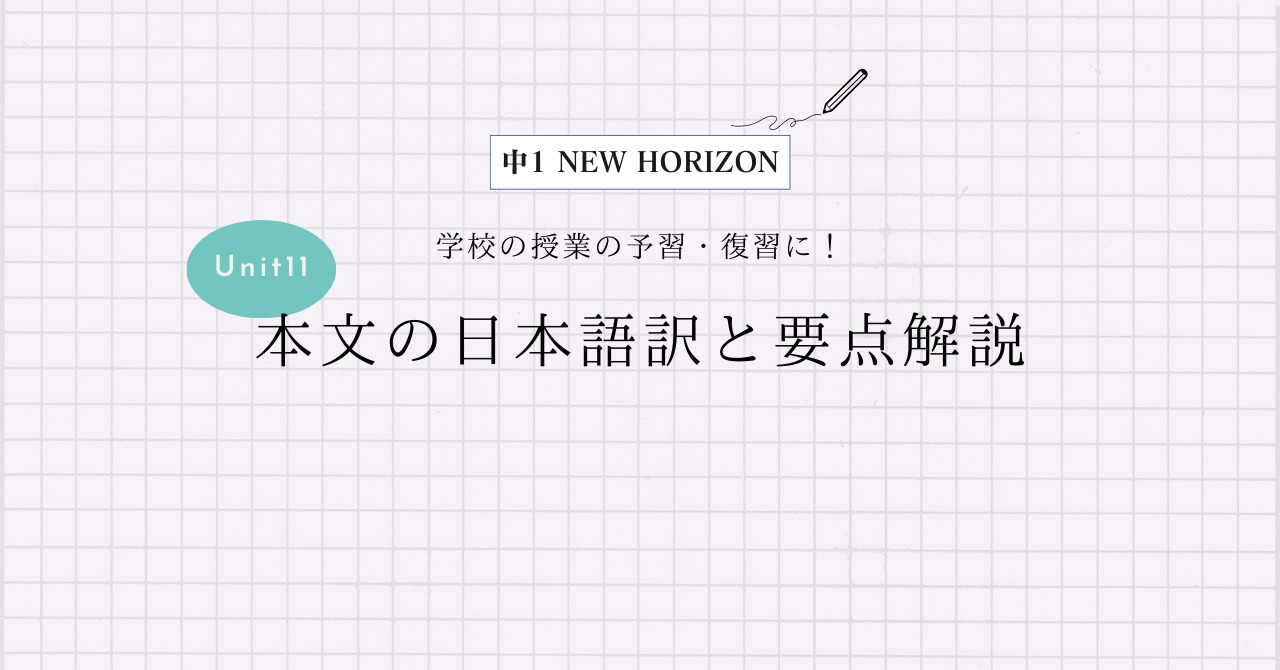東京書籍 中学1年生 NEW HORIZON(ニューホライズン) Unit11 Part2の本文の日本語訳と重要箇所の解説です。
Unit11-1,11-3の解説はこちらからご覧ください。
>中1NEW HORIZON Unit11 Part1 本文和訳
>中1NEW HORIZON Unit11 Part3 本文和訳
- Unit11 Part2 本文と日本語訳
- Unit11 Part2 重要事項の解説
- In July, we went to Lake Sakura on our school camping trip.
- Lake Sakura is at the foot of Mt. Asahi.
- Is there a campground near the lake?
- Yes, there is.
- There are showers and outdoor kitchens, too.
- So we set up tents and stayed for two nights.
- Sounds like fun!
- Yes, but there was some trash near the lake, so we picked it up.
- Good job.
- Unit11 Part2 まとめ
Unit11 Part2 本文と日本語訳
Josh: In July, we went to Lake Sakura on our school camping trip.
「7月に,僕たちは学校のキャンプ旅行でさくら湖に行きました。」
Lake Sakura is at the foot of Mt. Asahi.
「さくら湖はあさひ山のふもとにあります。」
Ms Cook: Is there a campground near the lake?
「湖の近くにキャンプ場があるの?」
Josh: Yes, there is.
「そうです。」
There are showers and outdoor kitchens, too.
「シャワーと屋外キッチンもあります。」
So we set up tents and stayed for two nights.
「だから僕たちはテントを組み立てて,2泊しました。」
Ms. Cook: Sounds like fun!
「楽しそうだね!」
Was it beautiful there?
「そこは綺麗だった?」
Josh: Yes, but there was some trash near the lake, so we picked it up.
「はい,でも湖の近くにごみがあったので拾いました。」
Ms. Cook: Good job.
「素晴らしいね。」

Unit11 Part2 重要事項の解説
In July, we went to Lake Sakura on our school camping trip.
“in 月”で「~月に」ですね。前置詞は“in”を使いますよ。
“trip”は「旅行」という名詞で,“school camping trip”は「学校のキャンプ旅行」とそのまま訳しました。
Lake Sakura is at the foot of Mt. Asahi.
“at the foot of~”は「~のふもとに」という意味になります。
Is there a campground near the lake?
この文では「there構文」が使われています。
“campground”は「キャンプ場」,“lake”は「湖」という名詞で,“near”は「の近くに」という前置詞です。
Yes, there is.
「there構文」の疑問文に対しては“there”を主語にして答えます。
There are showers and outdoor kitchens, too.
この文でも「there構文」が使われています。
“shower”は「シャワー」という名詞で,“outdoor”は「屋外の,野外の」という形容詞になります。
“too”はカンマとセットで文末に付けると「~も」という意味になりますね。
So we set up tents and stayed for two nights.
“so”は「だから」という接続詞です。
“set up”は「セットする,組み立てる」という意味で,この文の“set”は過去形ですね。
過去形も過去分詞形もすべて“set”になります。
“stay for ~ nights”は「~泊する」という表現ですね。
Sounds like fun!
“Sounds like 名詞”で「~そうですね」という重要表現です。会話でよく使われます。
“sound”は名詞だと「音」,動詞だと「~に聞こえる」という意味があります。
“fun”は「楽しさ」という名詞ですね。
Yes, but there was some trash near the lake, so we picked it up.
この文でも「there構文」が使われています。
“some”は「いくつかの」という形容詞ですが,後ろには数えられる名詞(可算名詞)と数えられない名詞(不可算名詞)のどちらも置くことができます。
“trash”は「ごみ」という不可算名詞です。
“pick up”は「を拾う」という表現で,代名詞とセットの時は”pick 代名詞 up”の語順になります。
“it”は“trash”を指していますね。
Good job.
“Good job”は「よくやった」といった相手を褒める表現ですね。
Unit11 Part2 まとめ
以上がUnit11 Part2の日本語訳となります。
ここでは「there構文」がポイントです。意味と使い方をしっかりと理解しておきましょう!
>中1NEW HORIZON Unit11 Part1 本文和訳
>中1NEW HORIZON Unit11 Part3 本文和訳
何か分からない点や他に解説してほしい点があれば,お気軽にコメントしてください!


コメント
すごく良いサイトで役立ちます。
ただ、New Wordsなどがないので、そこを付け足してもらいたいです。
嬉しいお言葉ありがとうございます。New Wordsの一覧はありませんが、各文の解説をしている箇所に単語の意味と品詞を書いているので、そちらを参照していただければ幸いです。